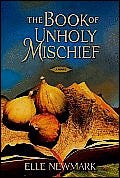The Book of Unholy Mischief features Luciano, a mischievous teenaged street urchin of late fifteenth-century Venice, who by sheer luck finds a place as apprentice to a fatherly chef in the palace of the doge. All Venice is agog over a mysterious book said to contain a wondrous magical formula. Is it an alchemical secret for making gold? An infallible love potion? The secret to eternal youth? Everyone seems to have their own idea about the book, and everyone wants it, including the doge, who is willing to torture and kill to get it.
Luciano's chef has some mysterious secrets of his own locked in a cabinet he sometimes opens to prepare one of the special, mouthwatering recipes he allows no one to assist him with. Luciano conveys the dishes to the maids who wait on the doge. "Tender veal cutlets had been dipped in beaten eggs and seasoned flour, then lightly seared and served in a dark brown sauce. The presentation was completed with a sprinkle of lavender leaves and marigold petals—green and gold, like a spring morning—and served with a loaf of crusty bread rather than the customary glazed onions." But what is in the Sauce Nepenthes? And why does it have such an astonishing effect on the doge and his guest? Is it possible, Luciano wonders, that the chef knows something about the book everyone is questing after?
For a novel that involves hungry street children, secret police, torture chambers and unrequited love, The Book of Unholy Mischief is a surprisingly, irrepressibly cheerful book. The lusty descriptions of food are part of the reason, the swinging rhythm of the prose another, and perhaps the unobtrusive presence of Luciano's cat Bernardo is part of it, too. After all, everyone knows cats have nine lives. (2008, 372 pages including an Author's Note separating fact from fiction)




